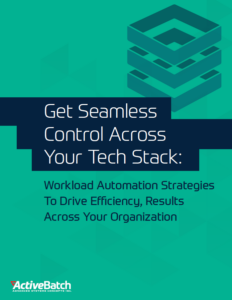Accelerate DevOps and IT Services With Workload Automation
IT is under pressure to quickly deliver innovative processes and digital services. Workload automation provides low-code tools for collaboration and efficiency.

The number of projects IT teams are responsible for is increasing, yet 51% of businesses think IT already takes too long to deliver digital products, according to a survey report from MuleSoft.
There are many reasons why IT teams can be slow to meet business needs, including skills gaps, slow processes, and too much time spent keeping the lights on. An additional 85% of IT teams reported integration challenges in MuleSoft’s survey report.
The problem is that many IT teams are managing fractured environments with multiple siloes. This makes it difficult to reliably manage data across IT and business systems, while increasing the time it takes to develop processes and services.
Workload automation and orchestration platforms (such as ActiveBatch) enable IT teams to centralize their automation environments so that processes can be developed, deployed, monitored, and maintained from a single point of control.
Let’s take a look at some of the features and practices developers can leverage through a low-code workload automation platform, in order to speed up the delivery of processes and services.
(The following is an excerpt from our latest ebook, “Get Seamless Control Across Your Tech Stack.”)
Prebuilt Connectors
Low-code workload automation platforms provide prebuilt integrations with a variety of major vendors including Microsoft, Amazon, Oracle, and VMware. These integrations can cover hundreds of automated tasks that reduce the need for custom scripting, and are rigorously tested and maintained to ensure reliability.
Aside from direct integrations, low-code platforms can also provide universal connectors for common actions and functions, such as file movements and flow control. Object-oriented platforms treat each of these connectors as objects, giving developers additional flexibility by abstracting away complex code.
With a comprehensive library of prebuilt connectors, developers can easily assemble end-to-end processes.
REST API Adapters
REST API adapters make it easy to integrate any software or service with an API. IT can use REST API calls from any in-house or third-party library, in conjunction with direct integrations, custom scripts, and universal connectors, in order to build reusable processes.
REST API adapters can support a variety of content types including JSON, XML, Raw, and URL encoded for additional flexibility. API testing can also be completed within the API adapters, providing developers with status codes and responses without having to wait for the job load to execute.
The right API adapters can make it easy for IT to connect any endpoint with an API, with intuitive UIs and authentication wizards that further reduce barriers to entry.
Drag-and-Drop Workflow Designer
Low-code IT automation platforms provide reusable objects, or jobs, that are abstractions of complex code. This makes it possible for developers to assemble those objects into workflows, with or without writing custom scripts. Each object within an end-to-end process can be configured independently or as a group, with granular business rules and approval processes.
Check-Out | Check-In
Check-out/check-in features allow multiple users to work on the same objects simultaneously. Conflict resolution is usually included to ensure that work isn’t overwritten and that conflicts don’t go unnoticed. Multiple changes can be pushed at the same time, as well as rolled back.
Job Templates
New processes can be turned into templates that allow the same logic to be reused ad infinitum. Any change to the process template can then be cascaded to all processes that reference the template. This can drastically reduce the time your team spends managing automated processes.
Change Management
Once your processes are developed and tested, they’re ready for production. Change management tools can be used to streamline promotions between environments, reducing delays and allowing your team to update workflows in multiple locations simultaneously.
Simulation Testing
Testing processes in a QA environment is routine. As an alternative, simulation testing enables your team to identify and resolve issues without having to execute the process and wait for payloads to complete.
Documentation
No one enjoys having to decipher someone else’s code or workflow, especially when the original developer is no longer around. Self-documenting objects and workflows can provide visibility into a developer’s logic, preventing knowledge loss.
Script Management
Many IT teams still rely on scripts that were written and optimized for specific applications or services. Script vaults can help secure and centralize these scripts, while audits and revision trails help reduce errors. Authorization requirements can limit access and editing rights, and documentation rules can make it clear what a script was intended to do.
Streamline DevOps With Centralized Automation
By centralizing your automation environment, developers can more easily build cross-platform processes that support business goals and deliver new services. Additionally, by centralizing control under a single platform, IT operations can be optimized and streamlined, meaning your team spends less time fighting fires and keeping the lights on, and more time innovating.
Don’t Settle For Unreliable Automation
Improve reliability and extensibility across your environment with the right workload automation strategies and tools.








